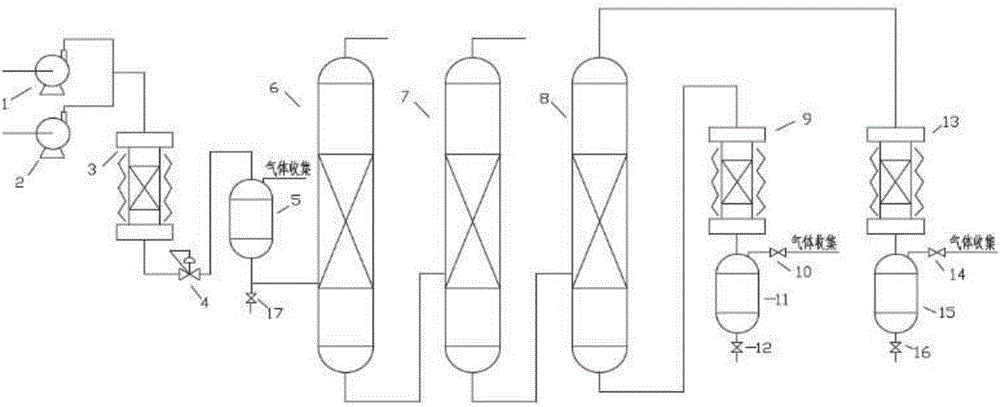Method for separating m-cresol and p-cresol mixture by liquid-phase alkylation method
An alkylation method and p-cresol technology, applied in chemical instruments and methods, preparation of organic compounds, organic chemistry, etc., can solve problems such as high production costs, polluting the environment, low utilization rate of alkylating agents, etc., and achieve improvement Effect of conversion rate, reduction of environment, and improvement of throughput
- Summary
- Abstract
- Description
- Claims
- Application Information
AI Technical Summary
Problems solved by technology
Method used
Image
Examples
Embodiment 1
[0036] Inner diameter 20mm, high 400mm tubular fixed-bed reactor is filled with 100ml of Amberlyst 15 type ion exchange resin, this catalyst is a known product, sold by Rohm and Haas China.
[0037] Step 1: Alkylation Process
[0038] Alkylating agent (volume ratio): 10% isobutene, 20% isobutane, 20% butane, 30% propane;
[0039] Mixed phenols (mass ratio): m-cresol 10%, p-cresol 90%;
[0040] Turn on the alkylating agent pump 1 and keep the pressure, the pressure keeping condition is 1.7MPa, and the space velocity is 0.8h -1 , adjust the temperature of the fixed bed reactor 3 to 50°C, turn on the mixed phenol pump 2, and feed the phenol at a molar ratio of 0.5:1 to carry out the alkylation reaction, and the product tank 5 obtains the alkylated product. The alkylation product that obtains is carried out GC-MS analysis, the result shows: p-cresol accounts for 68.24%, m-cresol accounts for 8.28%, 4-tert-butyl p-cresol accounts for 16.53%, 6-tert-butyl m-cresol accounted for 2...
Embodiment example 2
[0047] Reactor used and catalyzer and its consumption are with embodiment case one.
[0048] Step 1: Alkylation Process
[0049] Alkylating agent (volume ratio): isobutene 15%, isobutane 30%, butane 25%, propane 30%;
[0050] Mixed phenols (mass ratio): m-cresol 50%, p-cresol 50%;
[0051] Turn on the alkylating agent pump 1 and keep the pressure, the pressure keeping condition is 2.3MPa, and the space velocity is 1.5h -1 , adjust the temperature of the fixed bed reactor 3 to 70°C, turn on the mixed phenol pump 2, and feed the alkenyl phenol at a molar ratio of 1:1 to carry out the alkylation reaction, and the product tank 5 obtains the alkylated product. The obtained alkylated product was analyzed by GC-MS, and the results are shown in Table 1.
[0052] Step Two: Separation Process
[0053] The obtained alkylation product enters the atmospheric pressure tower 6, and the isobutene self-polymerization product is separated at the top of the tower, and the tower bottom liquid...
Embodiment 3
[0058] The reactor, catalyst and mixed phenol composition used are the same as those in Example 1.
[0059] Step 1: Alkylation Process
[0060] Alkylating agent (volume ratio): 20% isobutene, 30% isobutane, 25% butane, 25% propane;
[0061] Mixed phenols (mass ratio): m-cresol 50%, p-cresol 50%;
[0062] Turn on the alkylating agent pump 1 and keep the pressure, the pressure keeping condition is 2.8MPa, and the space velocity is 2.5h -1 , adjust the temperature of the fixed bed reactor 3 to 85°C, turn on the mixed phenol pump 2, and feed the phenol at a molar ratio of 1.5:1 to carry out the alkylation reaction, and the product tank 5 obtains the alkylated product. The obtained alkylated product was analyzed by GC-MS, and the results are shown in Table 1.
[0063] Step Two: Separation Process
[0064] The obtained alkylation product enters the atmospheric pressure tower 6, and the isobutene self-polymerization product is separated at the top of the tower, and the tower bott...
PUM
 Login to View More
Login to View More Abstract
Description
Claims
Application Information
 Login to View More
Login to View More - R&D
- Intellectual Property
- Life Sciences
- Materials
- Tech Scout
- Unparalleled Data Quality
- Higher Quality Content
- 60% Fewer Hallucinations
Browse by: Latest US Patents, China's latest patents, Technical Efficacy Thesaurus, Application Domain, Technology Topic, Popular Technical Reports.
© 2025 PatSnap. All rights reserved.Legal|Privacy policy|Modern Slavery Act Transparency Statement|Sitemap|About US| Contact US: help@patsnap.com



